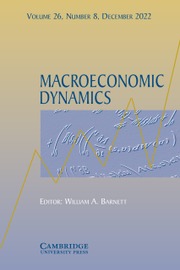Article contents
VOLUME–VOLATILITY DYNAMICS IN AN INTERTEMPORAL ASSET PRICING MODEL
Published online by Cambridge University Press: 16 January 2001
Abstract
This paper embeds time-varying volatility into a dynamic equilibrium model of returns and trading. The model allows us to ask how time-varying volatilitymight affect the relation among return autocorrelation, volatility, andtrading volume, as opposed to the pairwise relations that have been studiedpreviously. It is shown analytically that, with time-varyingvolatility, the relationship between volume and stock returnautocorrelation is ambiguous even if agents have symmetric information, which may explain thecontradictory findings in the empirical literature. In the numerical exercise, the model is simulated in a way that mimics the persistent volatility of high-frequencystock datadocumented in numerous empirical studies. Specially, the time-varying volatilityof stock returns is approximated with a highly persistent chaotic tent map, which isknown to havethe same autocorrelation coefficients as an AR(1) process.The simulated data can approximate GARCH-typebehavior very well. Whereas in the simulated data, no significant relation between volume and return autocorrelationcan be found, there is a significantly positive relationbetween volume and one-step-ahead stock return volatility. The ambiguousvolume–persistence and positive volume–volatility relations are confirmed empirically byusing four heavily traded individual stocks. Therefore, the data simulated from the highly stylized asset pricing model with deterministic time-varying volatilitycan mimic well the volume–return dynamics revealed in the observed data in these two respects.
Information
- Type
- Research Article
- Information
- Copyright
- © 2000 Cambridge University Press
- 2
- Cited by

